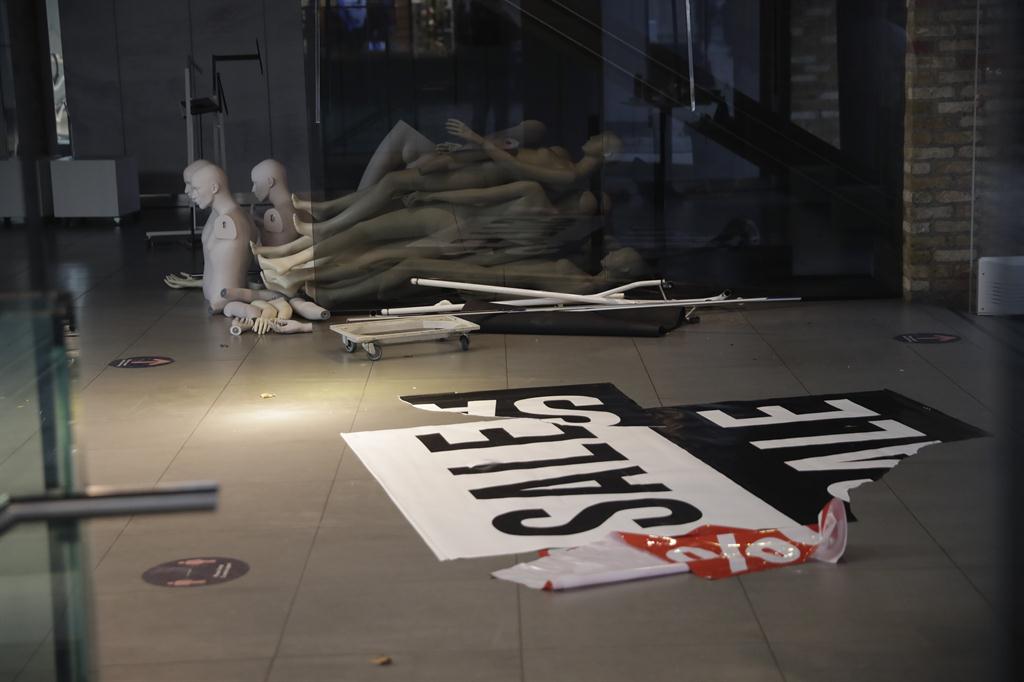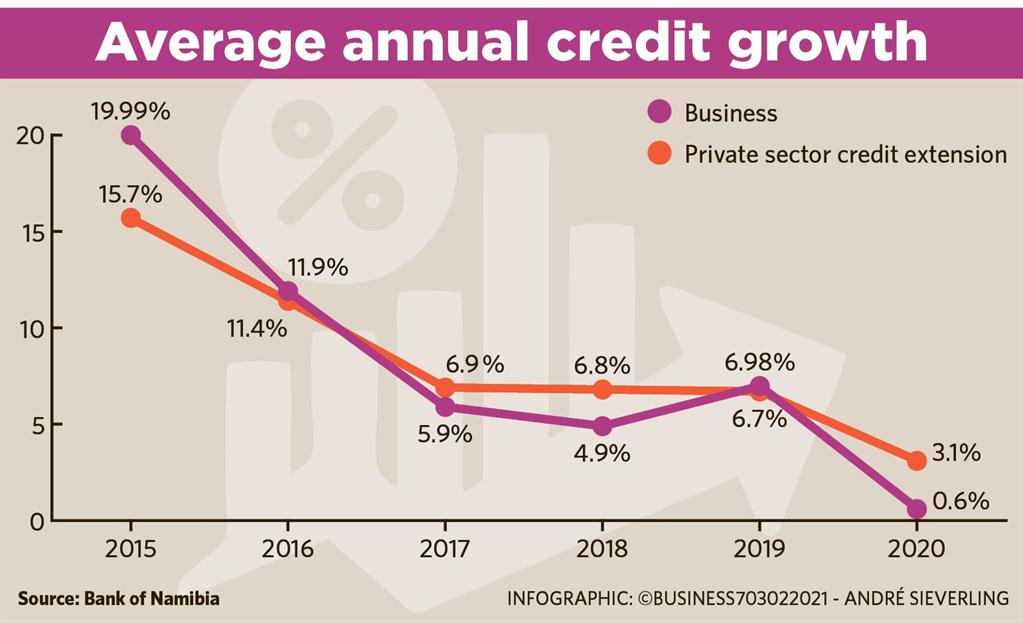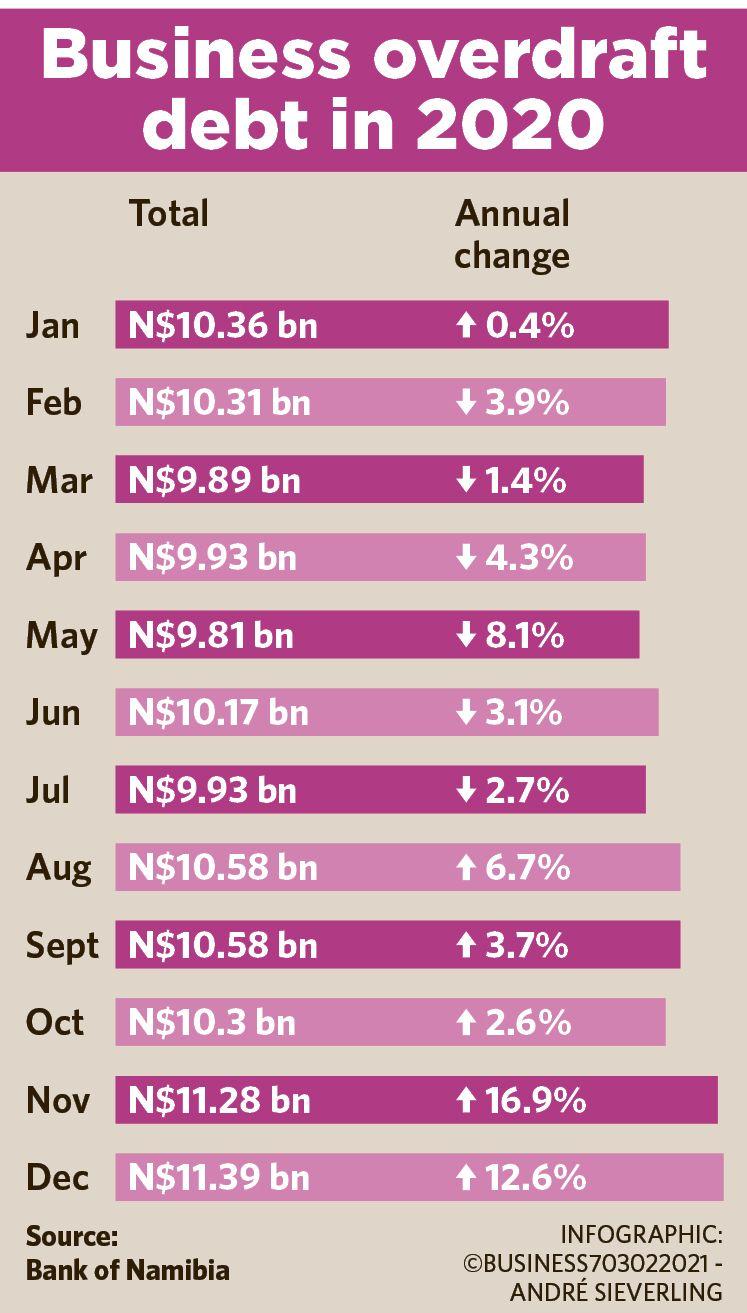Business credit grows cold
Business’ temperature is expected to remain chilly this year as the consumer struggle to recover from the impact of the ongoing recession and Covid-19.
Jo-Maré Duddy – Commercial bank credit extended to businesses in 2020 recorded six months of negative growth, reflecting the corporate’s sector struggle for survival, which is expected to continue this year.
The average growth in business credit extension last year was 0.6%. Overall private sector credit extension (PSCE) – money lend to individuals and corporates – averaged 3.1%. In 2015, the year before Namibia entered its current recessionary cycle, growth was 19.99% and 15.7% respectively.
IJG Securities says 2020’s annual PSCE growth statistics are the lowest on their records dating back 2002.
Data released by the Bank of Namibia (BoN) shows businesses owed commercial banks about N$44.3 billion in total at the end of December. This is N$546 million or 1.2% less than the end of 2019.
INVESTMENT
Total mortgage loan debt of businesses decreased by around N$1.17 billion or 8.7% to nearly N$12.4 billion.
“The decrease in mortgage advances is reflective of subdued economic activity and uncertain recovery prospects, resulting in the delay of expansion projects and reducing asset backed credit extension,” Simonis Storm (SS) says.
According to Cirrus Securities, the wide-ranging impact of the Covid-19 pandemic and ensuing lockdowns will have, at best, put a hold on many investment initiatives from the private sector.
“Rather, funding for such endeavours may well rather have been used to ensure continued operation (where there was disruption) or used to build up reserves to withstand extended shocks (given the uncertain operating environment),” Cirrus says.
OVERDRAFTS
Credit extended in the category for other loans and advances rose by a mere N$14.1 million or 0.1% from December 2019 to December 2020.
Overdraft debt, however, surged by nearly N$1.3 billion or 12.6% to N$11.4 billion during the year under review.
Commenting on the increase, Cirrus Securities says: “Strong reliance on these facilities in the current environment is understandable yet worrying, as the initial supply shock and latent demand shock mean the operating environment will remain suppressed.”
Instalment and leasing credit at the end of last year stood at about N$3.5 billion, dropping by N$661.2 million or 15.8% from the end of 2019.
Cirrus anticipates that business will continue to struggle to access finance at previous rates, “as the mismatch between administered and market-determined rates discourage commercial lending”.
“Given the increased risk and slow recovery expected, access to finance may still be constrained – particularly for firms in the construction, tourism and aviation industries,” the analysts say.
DEMAND RECOVERY
Domestic demand recovery will be one of the crucial drivers of economic recovery. Household consumption is the largest contributor to Namibia’s gross domestic product from the expenditure side and, according to Cirrus, generally accounts for roughly 70% of the total GDP.
The domestic demand shock resulting from the pandemic impact is concerning as it remains in its early phase, Cirrus says. “The local consumer entered Covid highly embattled, and this has been further exacerbated through the past year.”
Household indebtedness have been extremely high for several years, Cirrus points out, and this will further constrain a recovery in household spending in 2021.
BoN data shows that the average annual growth in overall credit extended to households in 2020 was 5.6%.
IN THE RED
Other loans and advances, which include personal loans and credit card debt, grew by 17.7% on average, while overdraft debt increased by 9.2%. At the end of 2020, households owed banks about N$9.7 billion in other loans and advances, while overdraft debt totalled N$2.45 billion.
The closure, downscaling, retrenchments and restructuring of many businesses in the aftermath of the pandemic outbreak – likely to continue this year – have caused aggregate household income to fall dramatically. Cirrus foresees “no immediate signs of material recovery and re-employment visible over the next few years”.
“As such, volume and value sales through wholesale and retail outlets can be expected to remain depressed, particularly where non-necessity items are concerned,” the analysts say.
Cirrus expects the retail space to remain under pressure, “especially for entities providing services to less resilient, lower LSM [living standards measure] clients”.
The average growth in business credit extension last year was 0.6%. Overall private sector credit extension (PSCE) – money lend to individuals and corporates – averaged 3.1%. In 2015, the year before Namibia entered its current recessionary cycle, growth was 19.99% and 15.7% respectively.
IJG Securities says 2020’s annual PSCE growth statistics are the lowest on their records dating back 2002.
Data released by the Bank of Namibia (BoN) shows businesses owed commercial banks about N$44.3 billion in total at the end of December. This is N$546 million or 1.2% less than the end of 2019.
INVESTMENT
Total mortgage loan debt of businesses decreased by around N$1.17 billion or 8.7% to nearly N$12.4 billion.
“The decrease in mortgage advances is reflective of subdued economic activity and uncertain recovery prospects, resulting in the delay of expansion projects and reducing asset backed credit extension,” Simonis Storm (SS) says.
According to Cirrus Securities, the wide-ranging impact of the Covid-19 pandemic and ensuing lockdowns will have, at best, put a hold on many investment initiatives from the private sector.
“Rather, funding for such endeavours may well rather have been used to ensure continued operation (where there was disruption) or used to build up reserves to withstand extended shocks (given the uncertain operating environment),” Cirrus says.
OVERDRAFTS
Credit extended in the category for other loans and advances rose by a mere N$14.1 million or 0.1% from December 2019 to December 2020.
Overdraft debt, however, surged by nearly N$1.3 billion or 12.6% to N$11.4 billion during the year under review.
Commenting on the increase, Cirrus Securities says: “Strong reliance on these facilities in the current environment is understandable yet worrying, as the initial supply shock and latent demand shock mean the operating environment will remain suppressed.”
Instalment and leasing credit at the end of last year stood at about N$3.5 billion, dropping by N$661.2 million or 15.8% from the end of 2019.
Cirrus anticipates that business will continue to struggle to access finance at previous rates, “as the mismatch between administered and market-determined rates discourage commercial lending”.
“Given the increased risk and slow recovery expected, access to finance may still be constrained – particularly for firms in the construction, tourism and aviation industries,” the analysts say.
DEMAND RECOVERY
Domestic demand recovery will be one of the crucial drivers of economic recovery. Household consumption is the largest contributor to Namibia’s gross domestic product from the expenditure side and, according to Cirrus, generally accounts for roughly 70% of the total GDP.
The domestic demand shock resulting from the pandemic impact is concerning as it remains in its early phase, Cirrus says. “The local consumer entered Covid highly embattled, and this has been further exacerbated through the past year.”
Household indebtedness have been extremely high for several years, Cirrus points out, and this will further constrain a recovery in household spending in 2021.
BoN data shows that the average annual growth in overall credit extended to households in 2020 was 5.6%.
IN THE RED
Other loans and advances, which include personal loans and credit card debt, grew by 17.7% on average, while overdraft debt increased by 9.2%. At the end of 2020, households owed banks about N$9.7 billion in other loans and advances, while overdraft debt totalled N$2.45 billion.
The closure, downscaling, retrenchments and restructuring of many businesses in the aftermath of the pandemic outbreak – likely to continue this year – have caused aggregate household income to fall dramatically. Cirrus foresees “no immediate signs of material recovery and re-employment visible over the next few years”.
“As such, volume and value sales through wholesale and retail outlets can be expected to remain depressed, particularly where non-necessity items are concerned,” the analysts say.
Cirrus expects the retail space to remain under pressure, “especially for entities providing services to less resilient, lower LSM [living standards measure] clients”.







Kommentar
Allgemeine Zeitung
Zu diesem Artikel wurden keine Kommentare hinterlassen